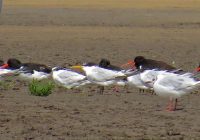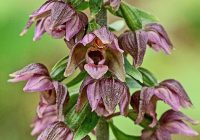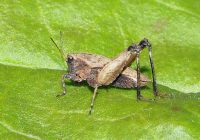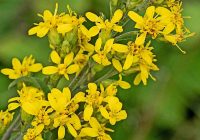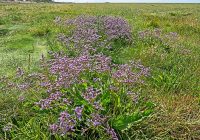Dr Phil Smith’s Wildlife Notes
August 2021
Guess what; another dry month! Measureable rain fell in Formby on about eight days but in significant amounts on only two. It was relatively sunny but there were also prolonged cloudy periods, due to the position of the high pressure system that dominated our weather.
The main excitement locally concerned an Elegant Tern (photo courtesy Pete Kinsella) that spent most of the month with a large flock of Sandwich Terns that habitually gathers in Liverpool Bay, prior to migration to West Africa. The Elegant Tern resembles a Sandwich Tern, except that it has a long thin orange-yellow bill. Its real home is on Pacific coasts of the tropical Americas, extending north to California. Needless to say, it is an extreme rarity in Britain but this bird had already spent the summer with the breeding Sandwich Terns at Cemlyn on Anglesey. The high-tide roost of Sandwich Terns, numbering up to 8000 according to some accounts, but more usually around 4000, gathered on the beaches between Hightown and Birkdale. While engaged in other surveys, I checked the Hightown roost a few times, to no avail. The nearest I got to the tern was on 10th, when I bumped into two friends returning to their car in a bad mood. A few minutes earlier, they had been on the Hightown side of the R. Alt, watching the Elegant Tern in a large roost on the usually restricted Altcar beach, when dog-walkers came down from the north and flushed the whole flock. I have mentioned before the problem of human disturbance to internationally important shore-bird roosts on the Sefton Coast. It seems to be getting worse. Because of the presence of the Rifle Range, the Altcar roost has been largely protected from disturbance but, over the last couple of years, when the ranges are not in use, some walk south from Formby, scattering the resting birds. As well as stressing them, this may cause the birds to use up resources needed for their migrations.
On a brighter note, my month with nature started well when Joyce and David Jarvis showed me two flowering Broad-leaved Helleborines at Ainsdale National Nature Reserve. I hadn’t seen this orchid on the Sefton Coast since 2008. Other notable plants during the month included a small colony of Whorl-grass that I found on a freshwater seepage zone on Hightown beach. It turned out to be the rare variety uniflora, largely confined to Western Scotland with only two known localities in England. While listing the associated species, I came across a plant that I couldn’t name but which seems to be Touch-me-not Balsam (Impatiens noli-tangere), not previously recorded for the Sefton Coast.
A trip to Marshside with Patricia Lockwood on 9th was rewarded with a spectacular purple vista of hundreds of Common, Lax-flowered and hybrid Sea-lavenders as far as the eye could see. It was great to find so many young plants, indicating successful breeding on this young, ungrazed, saltmarsh. On our return, Pat drew my attention to two Hornet Hoverflies on a Hebe in her front garden. These were the first of several sightings of these magnificent insects, the largest of their kind in Europe. Falklands Way at Ainsdale was especially productive. This strip of relict dunes, much abused by tree-planting, has many garden-escapes, one being a large patch of Snowberry. Its flowers were a magnet for several Hornet Hoverflies, together with their smaller, equally striking relatives, the Lesser Hornet Hoverfly and Pellucid Hoverfly. Nearby, I found two male Speckled Bush-crickets. A sap-run on the trunk of a poplar attracted the scarce hoverfly Fernandinea cuprea. Not far away, I came across a small patch of flowering Goldenrod, not the showy Canadian introduction but the smaller British native. I have only seen it here once before, at Ainsdale NNR in 2008.
Crossing the busy coast road to Ainsdale Sandhills Local Nature Reserve, I found lots of Mottled Grasshoppers on dune slopes where winter cattle-grazing has opened up the vegetation, creating bare patches needed by this specialist insect. Slacks cleared of scrub by Green Sefton last winter now support scarce colonisers such as Bristle Club-rush and the liverwort Cavernous Crystalwort, both in some quantity. While examining the liverwort, I spotted a tiny Common Groundhopper on one of the plants. In another cleared slack was a large patch of a tall slim Spike-rush which I assumed was Slender Spike-rush,one of our special plants. However, when I checked the flower structure, it was more like a Common Spike-rush. Could it be the rare hybrid between the two? Material sent to two experts was thought likely to be the hybrid, though neither would commit without genetic evidence.
Another of our superb nature reserves is Freshfield Dune Heath, managed by the Wildlife Trust. The flowering Heather is unmissable in August, attracting enormous number of bees. Among them was a tiny solitary bee, the Heather Colletes, my first sighting of this dry heathland specialist.

